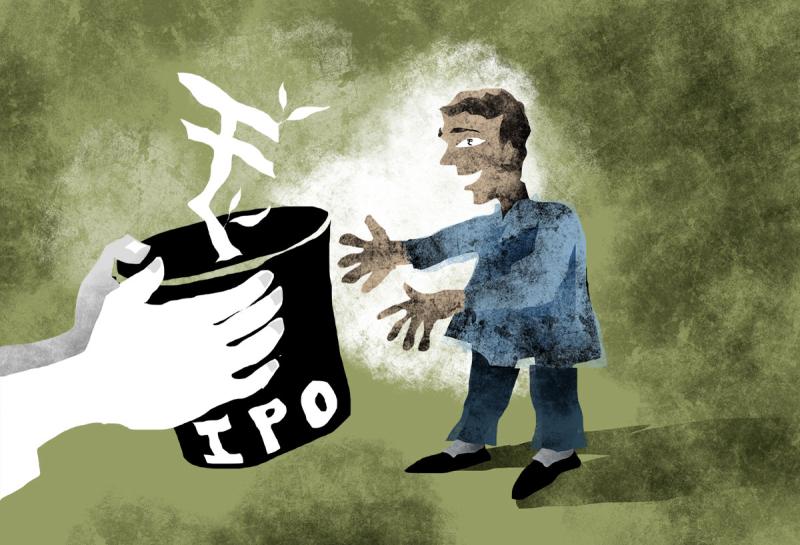Swiggy Records $200 Million Loss As It Plans IPO; The Trend Of Loss Making Companies Looking To Go The IPO Route
Swiggy has reported substantial losses despite its significant market presence with aspirations to go public this year backed by investment heavyweight SoftBank. The dynamics of startup funding and investor behavior in India often raise questions about the motivations behind investing in companies that are yet to turn a profit.

According to an internal document, Swiggy lost $200 million for the nine months ending December 2023.
According to sources familiar with the matter, the company, backed by SoftBank, is aiming for a stock market listing, potentially by the end of this year.
Despite the booming Indian stock market, concerns over high valuations and ongoing losses among Indian startups have led investors to exercise caution regarding IPOs.
For the fiscal year 2022-23, Swiggy reported a loss of 41.8 billion rupees ($500 million).
However, a source knowledgeable about the situation, who preferred to remain anonymous, said measures such as reduced wage payouts and marketing spending cuts are expected to help mitigate losses for the full year 2023-24.
The document reveals that losses amounted to 17.3 billion rupees ($207 million) during the initial nine months of the fiscal year 2023-24, against a revenue of $1.02 billion for the same period, compared to $1.05 billion in revenue for the fiscal year 2022-23.

While India’s stock market has seen a 28% surge over the past year with many companies planning listings, potential IPOs are currently being met with scrutiny from discerning investors.
Paytm, a digital payments firm still operating at a loss, faced an 80% drop in its shares since its 2021 listing, criticized for its high valuation.
Conversely, Swiggy’s competitor, Zomato, witnessed a decline in shares post-2021 listing, but a recent upswing of 45% this year after reporting consecutive quarterly profits.
Swiggy, initially focused on meal deliveries, has diversified its services to include grocery delivery and restaurant bookings; it was valued at $10.7 billion by investors in 2022.
Why Do Loss-Making Companies Choose IPOs Route In India
It seems almost improbable from a mathematical standpoint that, among the multitude of items available for sale on any given day, the most attractively priced one is being sold by “insiders” of a company to less-“informed” investors.
This sentiment, articulated by one of the world’s greatest investors, succinctly encapsulates the scenario we aim to elucidate.
Understanding Startup Funding
Startup funding refers to the capital required to establish and sustain a business, encompassing investments in inventory, office space, sales and marketing, manufacturing, product development, and expansion.
An initial public offering (IPO) marks the introduction of fresh shares of stock to the public for the first time by a privately held company, enabling it to raise equity funding from the general public.
The substantial losses incurred by investors have raised doubts about the IPO frenzy in the market during 2022.
Many investors poured significant funds into these IPOs, driven by FOMO (fear of missing out) and enticed by the promise of rapid wealth, only to be met with the harsh realities of market dynamics and company performance.
Expert analysis reveals that thorough due diligence and a solid grasp of a company’s fundamentals are crucial for making sound investment decisions amid the excitement surrounding IPOs, which often obscures inherent risks and can lead to substantial losses for inexperienced investors.

Why Do Indian Startups Fail? – Revealed Now
The Philosophy of Freebies and Discounts
The concept of using freebies as a marketing tool is nothing new; it has persisted for a considerable period.
It’s widely recognized that offering freebies and discounts is an effective way to attract customers, drive traffic, and increase sales. Over the past several years, many businesses have routinely offered complimentary products to win over customers to their brand.
The rationale behind this approach is simple – people love getting freebies. Whether it’s sampling products at a grocery store, receiving giveaways at trade shows, or winning prizes in contests, people are drawn to the allure of freebies.
Consequently, by providing customers with something of value, businesses promote their brand and encourage customer buy-in.
However, contemporary startups employ this strategy in a different manner.
Here are the steps –
- Establish a company.
- Acquire users through advertising and offering unique discounts and freebies.
- Showcase user acquisition to attract investors.
- Upon receiving angel funding, founders reward themselves generously and expand the team rapidly.
- When a significant investor shows interest, founders sell some shares to them, generating income.
- Subsequent investors enter, with founders and previous investors selling some of their shares to the new investor, further generating income.
- Repeat Step 6 as many times as possible.
- Either sell the company or shut it down.
- Regardless of the company’s outcome, founders and select investors stand to profit substantially by this stage.
While this oversimplifies the process, it outlines a general pattern that resembles a multi-level pyramid marketing operation.

Why do investors invest in loss-making startups? How do they make money?
Investors invest in startups that are operating at a loss because they anticipate making profits while the public may incur losses.
This can occur through various means –
1) Overvaluation and Pre-IPO Scams – Individuals or entities may occasionally engage in scams related to pre-IPOs. They may artificially inflate the value of a company or its assets to make them appear more attractive to potential investors.
This overvaluation creates the illusion of strong growth potential and profitability, attracting early-stage investors.
2) Advantage for Initial Investors – Early investors, such as venture capitalists or angel investors, participate in the initial funding rounds of startups.
If they invest at a significantly lower valuation before the artificial inflation, they stand to gain substantially when the company goes public at the inflated IPO price.
This disparity in valuation can result in significant earnings for early investors.
3) Pump-and-Dump Schemes – Entities sometimes engage in schemes to artificially inflate stock prices, employing tactics like spreading rumors or disseminating fake positive information to “pump” up the stock’s value.
Once the stock price reaches a certain level, these individuals or companies “dump” their shares by selling them at the inflated price, reaping significant profits while leaving ordinary investors with overpriced and potentially worthless securities.
4) IPOs to Offset Losses – Investors who have stakes in struggling or unprofitable startups may opt for an IPO as a means to exit.
Despite concerns about the company’s long-term financial viability, an IPO allows them to sell their ownership and recoup a portion of their investment.
Selling their shares to the general public at an inflated price enables them to turn a profit and mitigate their losses.
5) Public Losses – Retail investors, particularly those participating in IPOs or purchasing stocks after the company goes public, may buy shares at inflated prices due to a false perception of strong growth potential and profitability.
When the company’s true value is revealed or when the market bubble bursts, the stock price may plummet, resulting in financial losses for these investors.
)
Why Do Investors Keep Investing in Unprofitable Startups? (Explained)
Contemporary Indian startup founders boast about a supposed recipe for success – selling goods at unbelievably low prices while draining their investors dry.
However, this strategy raises serious doubts about the soundness of their business models and the sustainability of their ventures.
True business acumen lies in the ability to turn any venture profitable, demonstrating an understanding of market demands, crafting compelling business plans, delivering value to customers, and ensuring favorable returns for stakeholders.
Conversely, relying on selling goods at excessively low prices, as advocated by these “loss-making virtuosos,” may initially attract customers but often leads to financial turmoil when the funds run dry.
Recognizing the importance of maintaining sustainable pricing strategies is paramount.
When startups focus solely on unsustainable pricing without a clear path to profitability, they risk collapse, leaving employees without jobs, investors disillusioned, and customers seeking alternatives.
Many Indian startups have faced this reality, resorting to IPOs to recoup investor funds before ultimately shuttering their operations.
Why strive for genuine success when one can impress potential investors by showcasing expertise in hemorrhaging funds?
According to these startup gurus, convincing investors that their money is in the hands of brilliant minds capable of bleeding capital with finesse is the ultimate strategy for winning their confidence.
Meanwhile, those conventional, old-school businessmen remain focused on the arduous task of turning profits in a realm where logic still prevails.
How utterly mundane!
They may establish enduring enterprises that reward investors and provide value to customers, but why bother with that when you can simply ride the wave of hype and empty promises?

SEBI Tightens Its Oversight of IPO Fund Utilization
The thriving Indian stock market has spurred nearly 50 companies to embark on public offerings in 2023 alone. With eight offerings already completed, approximately 40 more await clearance from SEBI.
Recent reports suggest that India’s market regulator, SEBI, is intensifying its scrutiny of the documents submitted by companies seeking to go public, spurred by the increasing number of IPOs in the Indian market.
Moreover, companies intending to raise capital through IPOs must furnish precise details regarding the intended use of the funds; the heightened scrutiny of IPO disclosures has prompted several companies to revise their submission documents.
This action comes in response to observations that IPO funds are being diverted towards purposes divergent from those stated in the application to the regulator.
According to SEBI regulations, IPO funds may be allocated for capital expenditure, debt reduction, general corporate purposes, and acquisitions. If funds are utilized for debt reduction, promoters face an 18-month lock-in period for their shares.
Similarly, promoters are subjected to a three-year lock-in period if funds are raised for capital expenditure. The term “promoters” refers to a regulatory classification in India that encompasses significant shareholders capable of influencing company policy.
Currently, if the majority of IPO proceeds are earmarked for capital expenditure, the lock-in period for promoters’ shares extends to 36 months.
However, if the IPO-bound company specifies loan repayments as the objective, the lock-in period shortens to 18 months.
The Loophole
Despite declaring loan repayment as the designated use of IPO funds, SEBI has noted instances where companies divert them towards capital expenditure requirements; hence, SEBI has informally urged companies to adhere to the regulations.
As per guidelines, even if a new loan is obtained to repay an existing loan, promoters’ shares must be locked in for 36 months if the underlying loan finances capital expenditure. Regarding IPO proceeds utilized for working capital requirements, the lock-in period can be 18 months.
Investment bankers overseeing equity offerings have confirmed SEBI’s inquiries into companies’ loan details, borrowing purposes, and repayment schedules.
Indian companies aim to raise over ₹1 lakh crore through IPOs in 2024, double the amount raised in 2023.
While IPOs do not mandate profitability, the National Stock Exchange (NSE) requires companies to exhibit operating profit or earnings before interest, depreciation, and tax for at least two of the preceding three financial years.
However, investors tend to scrutinize trends in operating profitability rather than immediate net profit, especially when evaluating high-growth startups.
The Perspective
Why Are Loss-Making Companies Granted IPO Listings?
The decision to permit loss-making companies to seek IPO listings has ignited substantial debate and elicited concerns from investors and industry experts alike.
While not a novel practice, recent events have brought renewed attention to the risks associated with such ventures.
One key argument supporting the allowance of loss-making companies to go public revolves around the idea of fostering innovation and expansion. Many startups operate within sectors characterized by rapid technological advancements and fierce competition.
Granting these companies access to public capital markets can furnish them with the essential resources needed to drive their growth, invest in research and development, and scale their activities.
Proponents contend that this approach nurtures entrepreneurship and enables companies to pursue ambitious objectives that may not yield immediate profitability but harbor potential for significant long-term gains.
However, detractors of this practice underscore the inherent risks it entails.
Historical evidence demonstrates that investing in loss-making enterprises can be highly speculative and volatile. Without a proven history of profitability, investors may face substantial financial losses if these companies fail to fulfill their promises or encounter unforeseen obstacles.
SEBI’s recent decision to scrutinize the utilization of IPO funds is a positive development; however, permitting loss-making companies to pursue IPO listings raises concerns regarding market integrity and investor protection.
The primary mandate of regulatory bodies like SEBI is to safeguard investor interests and uphold the integrity of capital markets.
Permitting companies with uncertain financial outlooks to access public markets without adequate scrutiny could erode investor confidence and expose unsuspecting investors to unwarranted risks.
Therefore, there is a pressing need to enhance disclosure requirements, conduct comprehensive due diligence on prospective issuers, and impose penalties for non-compliance with regulatory standards.
An illustrative example is Paytm, which came under ED scrutiny. Despite this, SEBI allowed Paytm to proceed with its IPO, which turned out to be a significant market debacle, as we have witnessed.






